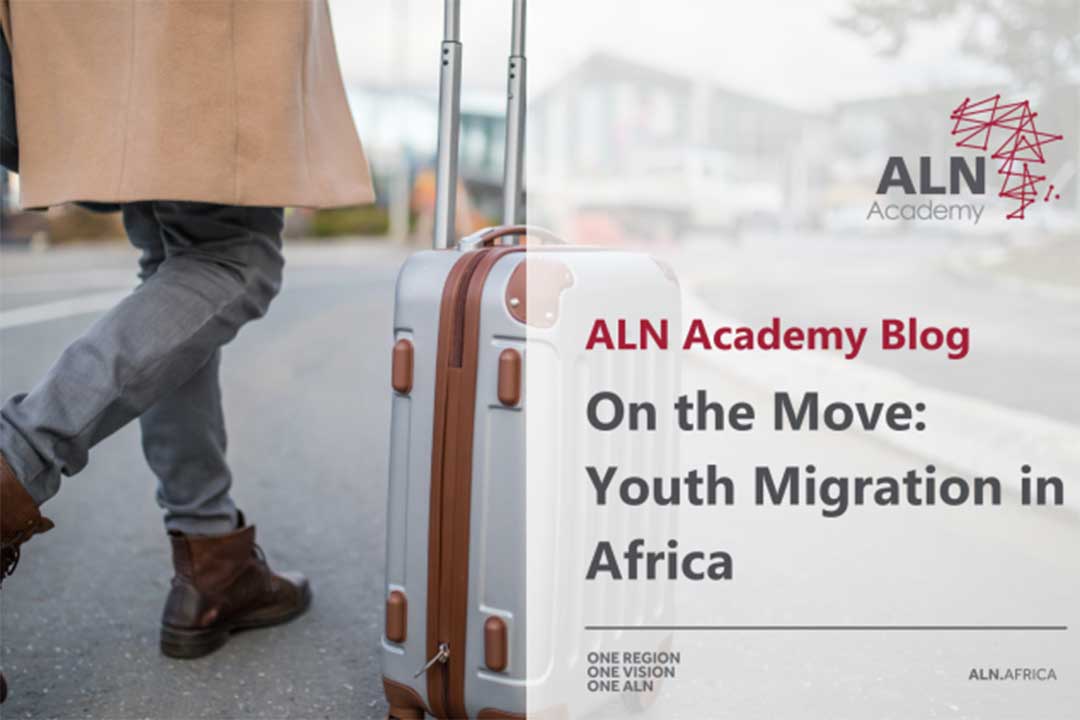On the Move: Youth Migration in Africa

Introduction
To migrate is to relocate, whether it is from a rural to a city setting, from one district or province to another within the same nation, or from one nation to another. The United Nations global estimate is that there were around 281 million international migrants in the world in 2020, which equates to 3.6 per cent of the global population. As a result, remaining in one’s nation of birth continues to be the norm for most people in the world. According to the World Economic Forum, “people perceive “livelihood crises” as one of the most potentially severe risks over the next decade, and millions are already seeking to cross borders in search of better economic opportunities.”
In Africa, conflict, oppressive governance, and limited economic opportunities are among the primary factors that fuel migration. Most Africans migrate within the African continent. Regional migration was affected by the COVID-related border closures across Africa. Surveys of African migrants state that the majority were either employed or in school at the time of their departure, yet they felt despair over their economic prospects. Tunisians fleeing economic pressure, for example, comprised more than a quarter of the undocumented migrants intercepted crossing the Mediterranean to Italy in 2021.
Youth Migration
According to International Labour Organisation, young migrants make up more than 10% of the 232 million total international migrants. Youth migration occurs in the context of high youth unemployment and a lack of decent job creation in home countries, and it gives the youth a chance to better their own lives and the lives of their families, pursue educational goals, improve their professional skills and prospects, or satisfy a desire for personal development through the adventures and challenges that come with migrating to a foreign country. According to the ILO, “the unemployment rate among youth in almost all countries is at least twice that of the general unemployment rate, and an estimated 73 million young people are estimated to be unemployed, according to the latest ILO Global Employment Trends for Youth report.” Unfortunately, as a result, many young migrants frequently get trapped in exploitative and abusive jobs, including forced labour. And too often, they, like other migrants, become scapegoats for the shortcomings of economic and social systems.”
The AU’s African Youth Charter claims that Africa’s youth are the continent’s most valuable resource and, if used, the continent’s expanding youth population provides immense potential. Africa’s youth are better off than previous generations thanks to advancements in health and education on the continent, providing them with better opportunities to advance human capital. According to the African Union’s Agenda 2063, the political, social, cultural, and economic change of the continent will be driven by the creativity, dynamism, and ingenuity of young Africans.
In Africa, migrations are viewed as a potential source for development, if well-managed. The facilitation of the free movement of people within the continent is a priority of Agenda 2063. However, a study by Gallup indicates that if everyone who wanted to leave the continent did so, Africa would be in danger of losing its human capital. The youth population would decline significantly in 40 of the 42 African nations with data. For instance, Nigeria would lose 57.0% of its youth population and Liberia would lose 70%.
Most of the refugee-welcoming countries close to conflict zones have reached the limit of their ability to provide accommodation.
Intercontinental Migration
Many African youths are thinking about emigrating, and more than half believe they are likely to at least contemplate doing so over the next three years, according to the Africa Youth Survey 2022. Nearly three-quarters of young people in Nigeria and Sudan and two-thirds of young people in Angola and Malawi are thinking about leaving their place of origin in the next few years. Youth who are thinking of leaving most frequently cite economic reasons (44%), such as seeking a career opportunity, and educational chances (41%), such as attending university. A quarter (25%) of people want to travel overseas to have fresh and diverse experiences. Europe is the most appealing region for African youth, followed by North America.
For migrants from the region and those from sub-Saharan Africa wanting to get to Europe and beyond, North Africa continues to be a key transit hub and point of departure. Despite the COVID-19 epidemic, there was a rise in travellers arriving in Europe via North Africa, going from more than 41,000 to over 77,000, an 86% increase. Two primary routes, the Central Mediterranean routes (mostly from Libya and Tunisia to Italy) and the Western Mediterranean routes (largely from Morocco and Algeria to Spain), are used by tens of thousands of migrants in their attempts to get from North Africa to Europe.
East African states like Kenya have historically sent the majority of their immigrants to Northern America and Europe. Nearly 157,000 Kenyans lived abroad in the United States and the United Kingdom in 2020. (around 139,000). Additionally, the 48 Gulf States have grown to be significant destinations for migrant labourers from Ethiopia, Kenya, and Uganda.
Intra-continental Migration
Given that many African nations do not keep track of migration, the estimated number of Africans living in another country within the continent is 21 million, which is likely an underestimate but still a significant increase from 2015, when around 18 million Africans were estimated to be living within the region.
Over time, intraregional migration in Eastern and Southern Africa has risen, in part due to the rise of migrant workers in the area. Even though they are still having significant implementation difficulties, integration initiatives like the East African Common Market Protocol in Eastern Africa have gradually made it simpler for individuals to conduct business across borders. The Southern African Development Community (SADC), which is made up of labour migrants from both within and outside of Southern Africa, has seen a growth in the number of international migrant workers similar to that of Eastern Africa.
East and Horn of Africa and the Great Lakes continue to be the origin and host of most African refugees, with more than 5 million from countries in the region in 2020. In 2020, South Sudan was the origin of the fourth largest number of refugees globally, at over 2 million. Somalia, another country in the sub-region affected by years of conflict and violence, was the origin of over 800,000 refugees. Uganda, with more than 1.4 million refugees, was the fourth largest host country of refugees in the world, mostly from South Sudan.
In West Africa, the predicted economic recovery following the 2020 COVID-19 pandemic could be hampered by sluggish investment in unstable countries. As a result of military coups in Chad, Guinea, Mali, and Burkina Faso, as well as an attempted coup in Guinea Bissau, this region will see increased mobility in 2022. Cote d’Ivoire will most certainly see a rise in the number of refugees from Mali and Burkina Faso.
Despite ongoing turmoil and bloodshed, North Africa continues to be the source and destination of a sizable number of refugees and internally displaced people (IDPs). A number of causes, including rivalry for natural resources, underdevelopment, and poverty, have also contributed to an upsurge in violence in the Central Sahel region, which includes Burkina Faso, Niger, and Mali. In Libya, a decade of violence and political unrest has driven hundreds of thousands of people from their homes and severely restricted access to essential services.
The cases above show that migration encompasses several issues and that one of the top tasks right now should be to give refugees improved access to housing, healthcare, and high-quality education considering the influx of migrants into various nations. Most of the refugee-welcoming countries close to conflict zones have reached the limit of their ability to provide accommodation. More financial resources are vital to fund the expansion of public services for refugees. Global cooperation is required to support the refugee issue as no nation can independently handle it. The international community’s assistance will be required to assist host countries in dealing with humanitarian disasters.
References
- Global Risks Report 2022. World Economic Forum. Published 2022. Accessed November 15, 2022. https://www.weforum.org/reports/global-risks-report-2022/in-full/chapter-4-barriers-to-migration/
- AYS2022. ICHIKOWITZ FAMILY FOUNDATION. Published 2022. Accessed November 15, 2022. https://ichikowitzfoundation.com/ays2022/
- Over Half of African Young Adults Are Likely to Consider Leaving Their Native Country. Wilson Center. Published 2020. Accessed November 15, 2022. https://www.wilsoncenter.org/blog-post/over-half-african-young-adults-are-likely-consider-leaving-their-native-country
- Flahaux ML, De Haas H. African migration: trends, patterns, drivers. Comparative Migration Studies. 2016;4(1). doi:10.1186/s40878-015-0015-6
- World Migration Report 2022: Chapter 3 – Migration and Migrants: Regional Dimensions and Developments. Iom.int. Published 2020. Accessed November 15, 2022. https://publications.iom.int/books/world-migration-report-2022-chapter-3
- Youth and migration (Labour migration). Ilo.org. Published 2014. Accessed November 15, 2022. https://www.ilo.org/global/topics/labour-migration/policy-areas/youth-and-migration/lang–en/index.htm
